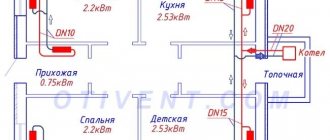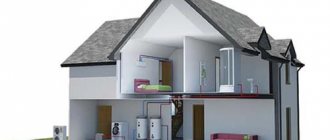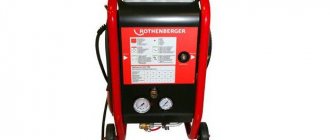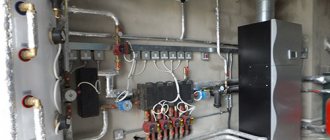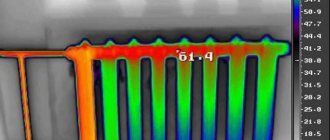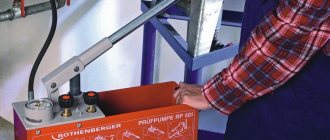Why is balancing necessary?
During design calculations, the heat loss of each heated room is determined, and the calculated thermal power designed to compensate for it is determined. Based on it, an appropriate radiator or heated floor design is selected. In practice, exact compliance cannot be achieved due to the influence of the following factors:
- the power of radiators changes stepwise from model to model, with a certain step;
- when choosing a tee wiring diagram, the radiators are connected in series, and the heat exchanger farthest from the boiler receives the coolant, which gave up part of its heat in the previous sections of the circuit;
- with equal pipe diameters, the radiators closest to the boiler will pass most of the liquid flow through themselves;
- Open installation of heating pipes also contributes to heat losses.
An unbalanced home heating system wastes energy resources. To keep the distant rooms warm, you have to increase the boiler power and the pressure of the circulation pump. As a result, tropical heat sets in in the rooms next to the boiler room, but the periphery of the circuit is still cool.
This mode of operation of the system leads to an unjustified increase in heating costs and to a reduction in the service life of the main devices.
To cope with this situation, hydraulic balancing of the heating system should be carried out.
When balancing the heating system in a private home, the following goals are achieved:
- setting the optimal temperature in each room;
- optimization of boiler operating mode and energy consumption;
- reduction in noise levels caused by the passage of large coolant flows through radiators located next to the boiler
Balancing is required for any heating system. It can be avoided only in the most modest one-story houses with 3-5 batteries, if pipes of the calculated diameter were used during installation.
How to balance a heating system in a private home
After installing a water heating system or after flushing and replacing the coolant, it requires adjustment, or, in technical terms, balancing. This procedure must also be performed if radiators have been changed or additional sections have been added to them. This article is dedicated to those homeowners who want to tackle this issue on their own. Its purpose is to suggest how to balance the heating system in a private home.
Why do balancing?
Any heating system, regardless of its type, must ensure that the calculated volume of coolant is delivered to the radiators so that they, in turn, can properly heat the room. Moreover, each radiator should receive exactly as much hot water as needed. In no case less and, preferably, no more. However, everyone knows that more water will always follow the path of least resistance.
Tools and devices for balancing
During the work, special tools and devices are used.
Balancing valve
A balancing valve is a type of shut-off and control valve that allows you to change the cross-section of a pipeline with great accuracy. Y-type devices are widely used. They have a handle with a scale of cross-section values printed on it. The housing has two built-in connectors for connecting a pressure gauge and a thermometer, or two pressure sensors for measuring the difference before and after the valve.
To balance the heating system you will need a balancing valve
Such valves are required to be installed under the following conditions:
- uneven heating in rooms;
- temperature instability in the rooms with constant boiler operation;
- At maximum power, some rooms are still cool.
When choosing a balancing valve model, you should pay attention to its connecting connectors; there must be appropriate connections for them on the pipeline.
During installation, you need to carefully monitor the compliance of the arrow stamped on the device body and the direction of coolant flow.
Measuring device
To adjust the balancing valve, you must use a special device. Its kit includes:
- temperature, pressure, coolant flow sensors;
- connecting cables;
- a central unit containing a display, keyboard and processor loaded with calculation and measurement programs.
The device can measure coolant flow parameters, detect errors in its distribution and make recommendations for correcting them by adjusting the valves. It is equipped with an interface for transferring measurement data to a personal computer, the software on which allows you to calculate flow parameters throughout the entire system and carry out balancing more quickly and conveniently.
Balancing the heating system.
When installing a heating system, there are typically a large number of inconsistencies that are very difficult to anticipate during the design process. Consequently, during a test run, the heating system releases heat and does not work as planned.
Inefficiency and failures of the heating system are not only associated with the wrong choice of equipment. Often, the coolant is simply consumed and distributed incorrectly in the system. If the coolant flow is insufficient, the air in the rooms does not warm up enough and the temperature in the room does not rise to the proper level. If the coolant is overused, overheating of the air will occur. Consequently, if there is overheating of air in one room, there should also be a lack of heat in adjacent rooms of the building. Single-pipe heating systems are extremely difficult to regulate. In order to adjust the operation of the installed heating system, it is necessary to balance it. Balancing the heating system is a hydraulic adjustment. Without such adjustment, efficient and long-term operation of the heating system is impossible. The result of balancing is the redistribution of the coolant throughout all closed sections of the heating system so that the required calculated volume of coolant passes through each heating device.
There is an opinion that balancing the heating system is only necessary in large buildings with many floors. However, the realities are different. For a small country house, for example, balancing the heating system is a very important task. Indeed, in an unbalanced heating system, heat consumption even in a small house can cause excess heat in those rooms where it is absolutely not required and an acute lack of heating where it is vitally important. It should also be taken into account that the more complex the heating system, the more deviations from the design and defective parts, as well as poorly installed elements, will be found in it. Therefore, balancing is necessary even for a one-story house. After all, a traditional heating system is already a rather complex thermal engineering structure.
Balancing the heating system is carried out, first of all, by adjusting the shut-off and control valves. This fitting controls the intensity of coolant movement. Neither automatic control systems nor thermostatic valves will be able to ensure the required distribution of coolant in the heating system. Therefore, these elements, although they help keep the temperature in the house more uniform, are not capable of balancing the heating on their own. In addition, such devices themselves periodically require maintenance and monitoring.
The fittings, which serve to balance the entire heating system, are made up of the following elements: flow regulators, balancing valves, bypass valves, pressure regulators. These elements change excessive pressure drop, which harms automation and thermostats. They also allow you to identify problems in the system, and also help eliminate breakdowns in individual areas of the heating system. Heating systems of different compositions also use different equipment for balancing. For example, in single-pipe systems, manual valves are used for balancing. For such simple systems this is quite enough. In two-pipe systems that use automatic thermostats, automatic balancing valves must be installed. They are installed so that the length of the straight pipe before and before the valve is at least 5 pipeline diameters. If such a device is installed after the circulation pump, then a distance of 10 pipeline diameters must be maintained. If this rule is not followed, then rather intense flows of a vortex nature will arise. They reduce the accuracy of adjustment. The valve size to balance the system must exactly match the diameter of the pipe.
There are several methods for balancing heating systems. The simplest and most popular, but also the most time-consuming, is multiple measurements that are performed on all balancing valves. The most effective balancing method is to divide the entire heating system into modules. In this case, a separate heating device, a group of heating devices, a riser with all branches, or a whole branch of heating devices can act as a module. One balancing valve must be installed at the output of each module. This valve will allow this module to work autonomously, or even independently. Therefore, this approach will allow all models to be balanced in relation to each other.
It is possible to gradually increase the number of balancing valves in the heating system. For example, you can first install one balancing valve by mounting it in the vicinity of the circulation pump. Then you can form valves on the entire risers of the system, etc. Before carrying out hydraulic balancing, you need to adjust the system. First, open all the valves and taps that were mounted on the pipes and in the area of the heating devices. Next, check the operation of the circulation pump and clean the filters (if necessary). After completing the above work, the pipelines are thoroughly washed and deaerated water is poured into them. Then the system is heated to operating temperatures and air is removed from the formed air pockets. If thermostat valves were installed on the pipes, then the heating system should be in operation for about a day. Balancing the hydraulics of the heating system guarantees long-term operation of pipes, fittings, heating boiler and the entire complex of devices in the system.
How is the heating system of an apartment building balanced?
We perform an audit of the heating system with subsequent restoration of heat supply parameters.
One of the main problems when balancing is the lack of exact flow rates for the risers; only data on the total flow rate for the entire apartment building is known. Because the houses were built a long time ago, it is possible that residents will replace heating radiators and make significant changes to the heat supply scheme of the apartment buildings, which will affect consumption.
The result of balancing should be a temperature of the same value at the control points. The return pipeline of each riser should be selected as control points. By the temperature of the return riser, you can understand what the temperature of the battery of the last consumer is.
Set the required flow rate for each heating riser, so that the return coolant temperature is in the range of +/-2 C.
The temperature on the radiators is different as a result
- Slow circulation of coolant through the riser.
- Large heat removal from heat exchange devices.
Reasons affecting the slowdown of circulation in the heating system riser:
- Changing the diameter of the pipe on the riser to a smaller value (narrowing the diameter of the pipeline). Installation of polypropylene (PP) and metal-plastic pipes instead of metal pipes.
- The use of pipeline fittings with high hydraulic resistance. Metal-plastic pipe fittings have a high coefficient of hydraulic resistance due to their small internal diameter.
- Dismantled bypass from the batteries. After dismantling the bypass, the calculated total diameter decreases (water flows not through two pipes, but through one), and the hydraulic resistance of the pipeline section increases accordingly.
Reasons for increased heat removal by heat exchangers:
- Connection of non-standard heat exchange equipment. Using coolant to heat underfloor heating.
- Increasing the number of heat exchange equipment. Installation of additional radiators and increasing the number of battery sections. Installation of heating devices in rooms not designed by the project for heating from the general building heating system - balconies and loggias.
Balancing the heating system of a multi-storey building
Types of connections
As mentioned above, according to the type of connection, apartment building systems can be single-pipe or double-pipe.
The single-pipe heating system of an apartment building has a huge number of disadvantages, the most significant of which is considered to be large heat loss along the way. In such a heating system for an apartment building, the design of which is simple, the coolant is supplied from the bottom up. Getting into apartment radiators on the lower floors and giving off heat, the water returns to the same pipe and, having cooled down considerably, continues its way upstairs. Hence the frequent complaints from residents of upper floors that the radiators in their apartments do not warm up well.
A two-pipe heating system in an apartment (the diagram can be viewed on the Internet) is most widespread in construction. The main distinctive feature of such a system is the presence of two highways: supply and return.
One pipe (supply) transports the coolant from the heating boiler to the heating devices. The second line (return) is necessary to remove already cooled water and return it back to the boiler room.
The main advantage of a two-pipe heating system in an apartment building is that the coolant is supplied to all heating devices evenly at the same temperature, regardless of whether the apartment is located on the first floor or on the sixteenth.
It is also important that the presence of two pipes greatly simplifies the process of flushing the heating systems of an apartment building.
There are two ways to arrange pipes combined into a single heating network: horizontal and vertical.
A horizontal heating network, which implies constant circulation of the coolant, is usually installed in low-rise buildings over a long distance (for example, in production workshops or warehouses), as well as in panel-frame houses.
A vertical two-pipe heating system for an apartment building is used in multi-storey buildings, where each floor is connected separately. The undeniable advantage of such a network is that there are practically no air jams in it.
Disadvantages of a one-pipe system
The disadvantages include the fact that with such a system it is impossible to take into account the heat consumption in each apartment. And, therefore, make an individual calculation of payment for the actual consumption of thermal energy. In addition, with such a system it is difficult to maintain the same air temperature in all living areas of the building.
That is why other apartment heating systems are used, which are designed differently and require the installation of heat energy meters in each apartment.
Currently, there are various apartment heating systems. However, so far they are installed in multi-storey buildings extremely rarely. This is due to a number of reasons. In particular, due to the fact that such systems have low hydraulic and thermal stability.
Most often, in multi-storey residential buildings, so-called central heating is used.
The coolant for such heating is supplied to the housing construction from the city thermal power plant.
In recent years, autonomous heating has been used in the construction of new residential buildings. With this method of individual heating, the boiler room is installed directly in the basement or attic of a high-rise building. In turn, heating systems are divided into open and closed. The first provide for the division of hot water supply for residents for heating and other needs, and in the other - only for heating.
Hydraulic balancing methods
There are several technologies for balancing heating systems, which you will read about below.
Balancing valves
The regulation technology consists of determining the temperature of all batteries and eliminating the difference using balancing valves. In order to adjust the system using balancing valves you need:
- Fully open all balancing valves in the system and heat the working fluid to 70-80 ˚C. If your boiler does not have a meter showing the actual water temperature at the inlet of the heating system, then determine it yourself using a contact electronic thermometer. To do this, attach the device to the metal outlet pipe of the boiler.
- On each of the radiators installed in the house, measure the temperature of the battery near the inlet and outlet of the working fluid and record the readings. If the differences in readings do not exceed 10 ˚C, then a separate radiator warms up normally.
- If the temperature difference at the inlet to the first and last heat exchanger is about 2 ˚C, then tighten the balancing valves of the first two heat exchangers by 0.5-1 turns, wait 10-20 minutes and repeat the measurements.
- When the temperature difference is more than 2, but less than 7 ˚C, the control valves of the first two batteries close by 50-70% (determine the degree of closure by the number of valve turns), located in the middle of the system by 30-40%, and the last 2 remain completely open.
- Continue adjusting the amount of hot water passing through the radiators until the noise disappears (if there was any) and/or the temperature difference at the inlet of the first and last heat source is reached, not exceeding 2 ˚C.
There is no need to get carried away with reducing the volume of working fluid passing through the radiator, as this will lead to a decrease in the temperature in the room without any significant economic effect.
Adjustment using thermostatic valves
Thermostatic valves are installed in space heating systems to which many consumers of thermal energy are connected, for example, in a two-story private house, in which, in addition to radiators, underfloor heating system pipelines, heated towel rails and other equipment are installed. The thermostatic valve “unites” the pipelines through which hot and cooled water is supplied and removed and allows it to be adjusted so that each high-temperature circuit supplied has similar temperature readings.
Hydraulic balancing using a pump
Adjusting the hydraulic parameters in the heating system of a building using the methods described above, if not labor-intensive, then takes a significant amount of time, and also does not exclude repetition of all actions in the future. Using a “smart” circulation pump, for example, Grundfos ALPHA 3, you can significantly simplify the process of hydraulic balancing of your heating system. Depending on the seller, the average cost of a kit that includes a detachable transmitter and special software for mobile devices is about $300.
The essence of the idea of balancing a heating system using a pump is the pump’s ability to control the coolant flow in each of the circuits and transmit the received information to the home owner’s smartphone or tablet. The program, which works as a guide, informs the homeowner about the measures and actions that must be taken to hydraulically balance the heating system. The information stored in the database about the types of heat exchangers, their power and the ability to enter other data (room area, required temperature indicators, etc.) allows you to simplify the process of adjusting the heating system as much as possible. It's so simple that you can change the heating system depending on the current readings of the thermometer outside.
Two-pipe heating systems for apartment buildings
Heating systems for multi-storey buildings are of the following types:
- vertical: single-pipe, double-pipe;
- horizontal: with two-pipe vertical risers and one-pipe horizontal apartment circuits, with two-pipe vertical risers and two-pipe horizontal apartment circuits.
The vertical type of system means that several vertical risers pass through an apartment from several rooms, at least one per room. In this case, apartment-by-apartment metering of consumed heat is impossible. Schemes of such systems are shown in the figure below.
1. Schemes of vertical systems of multi-storey buildings. a) single-pipe, b) double-pipe.
The horizontal type involves vertical risers on staircases with individual two-pipe inputs into apartments, allowing the installation of apartment heat meters, which are structurally part of the apartment heat control and metering unit (KURU), located inside or outside the apartment.
After entering the apartment, heating pipes can go around its perimeter or be laid radially from the front door. For a perimeter horizontal scheme, pipes and fittings of different diameters will be needed, which increases the cost. The calculation of such a system is quite complicated. For the radial installation option, pipes and fittings of the same standard size are needed, for example, DN 15 or 20 mm.
The calculation of such a scheme is easily done manually. The disadvantage is the need to pass all the pipes through the front door opening. Both horizontal two-pipe circuits are shown in the figure below.
2. Two-pipe horizontal apartment systems. a) perimeter scheme, b) radial scheme
ADVANTAGES OF AN INDIVIDUAL HEATING SYSTEM IN AN APARTMENT BUILDING
- The installation of a heating system in an apartment building allows utility companies to reduce tariffs for the services provided. In addition to financial savings, the consumer himself will be able to increase or decrease the temperature for heating the room at the time he needs. Thus, adjusting the heating system of an autonomous apartment building is an effective way to establish the optimal temperature regime.
Economic indicators when using apartment and centralized heating
- Individual heating of residential premises allows developers to slightly reduce the cost of square meters when commissioning a property. This is due to the fact that builders incur large costs when laying communications. In addition, the installation of heating in an autonomous apartment building allows developers to develop new territories remote from populated centers with all the infrastructure;
The fact of significant savings in natural gas, which runs the intra-house heating system of an apartment building, has been proven. Compared to heating an apartment with electricity, natural gas is economical.
- Using an autonomous heating system, it becomes possible to minimize heat waste on the way to the consumer. There is no need to additionally insulate the heating mains through which hot water is supplied to consumers' apartments, and balancing the heating system of a multi-story building is easy and relatively quick;
A double-circuit boiler not only heats the apartment but also provides hot water supply
For those who are rarely in their apartments, the optimal solution is to insulate the external surfaces of the room, which will allow them to retain heat for a long time and avoid structural damage due to moisture;
- Special attention can be paid to the ventilation system. When setting up the heating system of an apartment building and, in particular, gas-powered equipment, it is important to understand that decomposition products must be removed efficiently. It is in new buildings that there are all the necessary conditions for the implementation of the plan. Modern ventilation and cleaning systems are installed here. Thus, flushing the heating system of an apartment building will be carried out without problems, since the design already provides for it. To install autonomous heating for an apartment in an apartment building, it is important to coordinate everything with city managers and be sure to provide a design for the placement of the equipment.
What is the difference between the lower wiring and the upper wiring?
When installing lower wiring, the supply line is laid in the basement or basement, and the return line (the so-called “return”) is even lower.
To remove excess air when using bottom wiring, an upper air line is required. To ensure uniform distribution of coolant throughout the system, it is recommended to place the boiler as low as possible relative to the heating radiators.
Upper wiring is most often done in the attic, which must be well insulated. With this wiring method, an expansion tank is installed at the highest point of the heating system. The main advantage of the upper distribution is the high pressure in the supply lines.
Thank you for the information provided, websites: kotel.guru, kak-svoimi-rukami.com, strojdvor.ru, ruslanbelov.ru
Security group
The security group consists of three elements connected in series or to one housing:
An emergency safety valve that allows you to discharge excess coolant when the pressure in the system increases. The discharge can be placed in a transparent container (for example, a plastic bottle). This will make the device safer and will notify you that an emergency has occurred (even if no one was home). Automatic air vent - removes air from the coolant, which, if present in the heating system, can render it inoperative. Pressure gauge - allows you to visually monitor the coolant pressure in the supply line.
The safety group crashes into the supply line immediately at the outlet of the heating boiler. This is done in order to primarily protect the boiler, which has the highest temperature.
The safety group is installed strictly vertically, and it must be located above the level of the heating boiler.
An additional automatic air release valve should be installed at the highest point of the system. Air will definitely enter the system during its refueling (refueling), and this device will help stabilize the operation of the system, avoid stagnation of the coolant due to air accumulation and extend the life of the circulation pump.
Problems with the heating system
There are many problems that arise during the operation of the heating system:
- The presence of air that interferes with or blocks the circulation of coolant through the system. Sometimes customers replace circulation pumps with samples with greater power.
- Failure of equipment components.
- Clogged filters.
Modern buildings and structures require reconstruction of heating systems, since the hydraulic balancing of heating systems is usually disturbed, which entails an increase in heating costs.
The sooner the heating system is balanced, the faster the heating process of a building or room will normalize.
Problems with the operation of the heating system can only be eliminated with the involvement of specialists, since it is the professionals who will be able to create the correct distribution of heat transfer from the coolant.
Automatic debugging
There is a kind of golden mean between the two methods described above. Special equipment for automatic balancing of hydraulic heating systems allows adjustments to be made with very high accuracy and in a fairly short time. Currently, the main technical solution for such purposes is the Grundfos ALPHA 3 “smart” pump, equipped with a removable transmitter, as well as a proprietary application for mobile devices. The average price of a set of equipment is about $300.
What is the essence of the idea? The pump has a built-in flow meter and can exchange data with a smartphone or tablet, where all information is processed. The application works as a guide: it guides the user step by step and indicates what manipulations need to be carried out on different parts of the heating system. At the same time, individual rooms with a specified number of heating devices are saved in the application database; it is possible to select different types of radiators, indicate their power, required heating standards and other data.
The process is extremely simple and fully demonstrates the algorithm of the program. After pairing with the transmitter and preparing for operation, all radiators are disconnected from the system; this is necessary to measure zero flow. After this, the shut-off valves on each radiator are opened completely in turn. In this case, the flow meter in the pump notes changes in the flow and determines the maximum throughput of each heating device. After all radiators are entered into the program database, they are individually adjusted.
The shut-off valve on radiators is adjusted in real time. The application has a sound indication for the ability to work in hard-to-reach places. Balancing requires fine adjustment of the shut-off rod to a position at which the current flow rate in the system is equal to the value recommended by the program. Upon completion of work with each radiator, the application generates a report that includes all heating devices in the system and the coolant consumption in them. After balancing, the ALPHA 3 pump can be removed and replaced with another with similar performance parameters. published econet.ru
If you have any questions on this topic, ask them to the experts and readers of our project here.
Balancing methods
The setup procedure at home can be done in two ways:
- according to the calculated coolant flow using an electronic flow meter,
- Approximate temperature balancing.
The first method is the most accurate and requires the availability of a design and hydraulic calculation of the system indicating the water flow at each section of the pipeline. Without this, fine tuning of the system is impossible. In extreme cases, you can do the calculation yourself or contact a specialist in this field. The second component is control valves installed on each branch or riser. And third, a special electronic device for balancing, connected to the corresponding fittings.
Attention! Full bore ball valves are not control valves; they are designed to completely cut off or open the path to the coolant. The same applies to thermostatic radiator valves, whose task is to quantitatively regulate the heat supplied to the battery depending on the air temperature in the room.
The essence of the method is to use the device to determine the real coolant flow rate on each branch or riser of the system. To do this, a balancing valve with fittings for connecting the electronic unit must be installed on the return line branch. Having in hand a diagram with the indicated flow rates for each branch, all that remains is to connect the device to the valve fittings and adjust the required flow rate by turning the spindle. The heating system of a multi-storey building is also balanced in this way.
Note. Now on sale there are balance valves with a flow meter bulb, which allow you to make rough adjustments without a device.
When everything is designed and calculated correctly, all batteries located on an adjusted riser or branch will receive the required amount of heat. It is not customary to configure each heater using this method, especially if it is equipped with a thermostat.
Setting by temperature
Very often the homeowner does not have any design documentation, but the system was invented and assembled by the talented welder Uncle Vanya. Then all that remains is to regulate each battery by temperature.
To balance the heating system with your own hands, you need to install a special valve at the outlet of each radiator, such as shown in the photo. Additionally, you will need an electronic thermometer that measures the temperature on any surface.
For reference. You can balance the system the old way, using washers. But the passage hole in the washer still needs to be calculated based on the estimated coolant flow.
The process begins with the valve on the farthest and most powerful heating device fully opening. The rest open at a certain number of revolutions. For example, if there are 6 batteries on one branch, and the valve is unscrewed by 5 turns, then on the first radiator we make 1 turn, on the second - two, and so on, opening the last one all the way. Approximate balancing of a two-pipe heating system for a private house is to ensure that the temperature at the outlets of all heaters is the same.
To do this, you need to measure the temperature of the metal valve body. When it is high, cover it a little, if low, open it. The next measurement should be taken after 10 minutes so that the temperature has time to stabilize after the change.
Balancing tasks
The main goal of balancing is to redistribute coolant flow across closed areas, directing heat to places where there is a shortage of it. This procedure is relevant and appropriate in premises of any size, including private houses and country cottages. Reconstructing an old heating system is difficult and expensive, so in such a situation, clients often wonder how to balance the heating system.
This procedure is carried out in accordance with the state energy saving program; as a result of balancing, the consumption of coolants is significantly reduced, and monetary costs for heating are reduced.
Wiring of simple heating systems
A heating system can be called simple if it contains one direct circuit. A direct circuit means a line into which coolant is supplied from the boiler without changing the initial temperature. Some radiator heating systems are simple. They can be single-pipe, double-pipe or mixed. The most practical type of simple radiator heating is a two-pipe system based on a supply and return line.
And if its balancing is done correctly, such a system will ensure uniform heating of the radiators along the entire heating perimeter.
Let's consider the main elements of the system and their functions.
Expansion tank
A closed expansion tank is a tank equipped with a rubber membrane that divides the device into two parts (the lower half contains the coolant, and the upper half contains inert gas). When the temperature in the heating system increases, part of the coolant enters it, thereby smoothing out the pressure difference in the supply and return lines.
The tank can be installed in close proximity to the heating boiler. Additional shut-off valves (ball valve) installed in front of the tank entrance will make it easy to disconnect the tank from the system if there is a need to repair or replace it.
The need for heating
The need to heat your own home has always existed, but the ways to achieve this goal were very different.
For hundreds of years, classic Russian stoves were used in Russia, and a little later fireplaces appeared. Traditional heating structures have been replaced by modern devices and heat supply systems, which are superior in quality and efficiency to their predecessors. Currently, the heating system is a structure that usually consists of the following main elements:
- heating boiler;
- pipeline;
- heating appliances.
There is a coolant inside the heating system. In most cases, water is used to heat private households, since in case of leakage it does not pose a danger to people and the environment from an environmental point of view. Of all types of liquid coolants, it is water that accumulates heat best and, when cooled, releases it.
In addition, it flows well and moves almost instantly within the elements of the system. Water is always available in the water pipes and can be added to the heating structure at any time.
The functioning of the system consists of moving hot coolant through it using a circulation pump. The water is first heated in the boiler and then distributed through pipes from which it flows into the radiators.
Artificial intelligence wins the fight for the right settings
So far, the picture that emerges is not very clear: and you want to save money - a fifth of your utility costs are on heating! - and there are too many subtleties. Even if everything is done correctly, the result, alas, is not guaranteed. “Usually balancing is carried out before the heating season, but in severe frosts it turns out that the rooms have different thermal protection, which the owner, as it turned out, forgot to warn about. The homeowner, at his own discretion, increases the coolant flow in cold rooms, after which all work on setting up the system goes down the drain,” says Sergey Orlov (installer).
This drawback can be corrected using special computer programs for calculating heating systems, which, unlike manual methods, take into account the vast majority of factors. They determine the required coolant flow rate with high accuracy. All that remains is to set the recommended adjustments of the balancing valves. It is clear that for this method of balancing it is necessary to have the skill of using such calculation programs, as well as to have special balancing valves with calibration in the system. If balancing valves without special calibration were installed in the system, when setting up these valves it will be necessary to measure the flow rate with special flow meters in order to achieve the calculated flow rates in each radiator. All this, coupled with the need for special shut-off valves or special measuring equipment, makes the procedure very difficult for “beginners”.
But with the development of wireless communications and the transition from push-button mobile phones to smartphones, the computer balancing method has become simpler and more accessible: no special training is required. The engineers of the GRUNDFOS Concern were the first to implement it: they offered the market the ALPHA3 circulation pump with the ALPHA Reader communication module and developed the GRUNDFOS GO Balance application for smart phones and tablet computers.
According to homeowners who have tried the new product, balancing can now be done independently and with high accuracy. The whole process takes about an hour (for houses up to 200 sq. m.) and is carried out in several stages. First you need to install a new pump in the system and equip it with a communication module. Then you should download, install and launch the free application in close proximity to the communication module so that the smartphone and the pump “find” each other. Then all you have to do is follow simple and clear instructions: the program will ask you to enter data about the existing system and measure the exact coolant flow on each radiator. After entering the necessary information, the utility will calculate the required consumption for each battery, and two values will appear on the screen: current and recommended. All that remains is to adjust the balancing valve until the actual flow matches the calculated one.
“The need for such a tool has been long overdue, and GRUNDFOS specialists were the first and only ones to offer such a solution. Even before the start of sales of the new product, pre-orders were placed for the entire upcoming supply of ALPHA3 and Alpha Reader, says Ekaterina Semyonova (GRUNDFOS). — And this is not surprising, because, as I noted earlier, a well-functioning system allows you to save up to 20% of fuel (gas, coal, firewood). In addition, the GRUNDFOS ALPHA3 series pumps themselves are characterized by low energy consumption: they are 87% more economical than conventional units, for which they are recognized as the most energy-efficient in their class.”
Mobile technologies are the engine of progress. They help us not only cope with quite ordinary household issues, but also save money. And who knows, perhaps in the future engineers will delight homeowners with even more intelligent solutions.
Traditional balancing methods
Shut-off valves
The classic method involves installing a balancing valve on the return line of each heating battery.
By changing the position of its shut-off element, you can adjust the flow intensity. Options: throttle washers, needle valves. Plus: easy balancing. If installation is carried out correctly, professional skills are not required. But this is a theory; in practice everything is much more complicated.
Disadvantages: a large amount of work on inserting, inaccurate “tuning” of radiators. Even when using an electronic thermometer, significant errors cannot be avoided. In addition, this is a troublesome task that requires time: it will take at least a day to properly balance the heating in a private home.
Collector installation
“Combs” are inexpensive and are not in short supply. The meaning of the technique is to individually connect each thread in the supply and return. This solution is most popular in the private sector.
Pros: ease of balancing; more rational distribution of the coolant along the connected “loops”.
Cons: not for all heating schemes; the complete set of the “comb” (flow meters, taps, sensors) is expensive. But if you consider the real savings on heating a building, it’s worth the investment.
Before balancing, you need to make sure that the system is prepared. This means: there is no airing in any of the areas, the existing filters are washed, and the volume of coolant is optimal. Excessive pressure, as well as reduced pressure, will lead to errors in setting the heating circuit.
